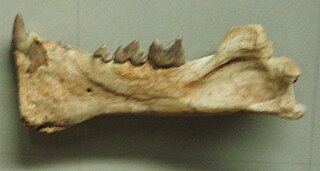
Colubridae is a family of snakes. With 249 genera, it is the largest snake family. The earliest species of the family date back to the Oligocene epoch. Colubrid snakes are found on every continent except Antarctica.

The Cricetidae are a family of rodents in the large and complex superfamily Muroidea. It includes true hamsters, voles, lemmings, and New World rats and mice. At almost 608 species, it is the second-largest family of mammals, and has members throughout the Americas, Europe and Asia.

The Eumuroida are a clade defined in 2004 by Steppan et al. that includes rats, mice and related species, though not all rodents; in other words, a specific group of muroid rodents. The clade is not defined in the standard taxonomic hierarchy, but it is between superfamily and family.

Papagomys is a genus of very large rats in the tribe Rattini of the subfamily Murinae. It contains two species, which are known only from the Indonesian island of Flores:

The Chitarwata Formation is a geological formation in western Pakistan, made up of Oligocene and early Miocene terrestrial fluvial facies. The sediments were deposited in coastal depositional environments when Pakistan was partly covered by the Tethys Ocean.

Barbourofelidae is an extinct family of carnivorans of the suborder Feliformia that lived in North America, Eurasia and Africa during the Miocene epoch and existed for about 7.9 million years .

Verhoeven's giant tree rat is an extinct rat of subfamily Murinae that lived on Flores in Indonesia. It was judged to be extinct in 1996. However, experts believe that it died out before 1500 AD. The species is known only from several subfossil fragments. It was named after Dutch priest Theodor Verhoeven. A 1974 report of a recent specimen has been judged to represent P. armandvillei instead.

Prosansanosmilus is an extinct genus of mammalian carnivores of the suborder Feliformia, family Barbourofelidae, which lived in Europe during the Miocene epoch, existing for approximately 0.9 million years .

The Orleanian age is a period of geologic time, within the Miocene and used more specifically with European Land Mammal Ages. It precedes the Astaracian age and follows the Agenian age.
Karydomys is a genus of fossil Eurasian hamster-like rodents in the subfamily Democricetodontinae from the Langhian stage in the middle Miocene epoch.
Rodents of the superfamily Muroidea, which includes mice, rats, voles, hamsters, bamboo rats, and many other species, generally have three molars in each quadrant of the jaws. A few of the oldest species retain the fourth upper premolar, and some living species have lost the third and even the second molars. Features of the molar crown are often used in muroid taxonomy, and many different systems have been proposed to name these features.
Paronychomys is an extinct genus of Cricetidae that existed in Arizona during the Hemphillian period.
Turiasorex is an extinct genus of shrew which existed in east central Spain, during the middle and late Miocene. Its fossils have been recovered from the Calatayud-Daroca and Teruel basins, Spain. It was first named by Jan A. van Dam, Lars W. van den Hoek Ostende and Jelle W. F. Reumer in 2011 and the type species is Turiasorex pierremeini.

Cyclemys enigmatica, tentatively dubbed as the enigmatic leaf turtle, is a species of Asian leaf turtle found in the Greater Sunda Islands.
Galerix kostakii is a fossil erinaceid mammal from the early Miocene of Greece. It is known from the site of Karydia, assigned to the biostratigraphical zone MN 4; similar fossils have been found at an approximately contemporary Czech site and a slightly younger Greek site. With characters like the presence of a hypocone on the upper third premolar, the presence of a connection between the protocone and metaconule cusps on the second upper molar in only a few specimens, this species is intermediate between the slightly older Galerix symeonidisi and the slightly younger Parasorex pristinus. It may form part of the lineage leading from the genus Galerix to the younger genus Parasorex.
This article records new taxa of fossil mammals of every kind that have been described during the year 2014, as well as other significant discoveries and events related to paleontology of mammals that occurred in the year 2014.
This article records new taxa of fossil mammals of every kind that have been described during the year 2011, as well as other significant discoveries and events related to paleontology of mammals that occurred in the year 2011.
This article records new taxa of fossil mammals of every kind that have been described during the year 2010, as well as other significant discoveries and events related to paleontology of mammals that occurred in the year 2010.
Siamoperadectes is a genus of non-marsupial metatherian from the Miocene of Thailand. A member of Peradectidae, it is the first member of its clade known from South Asia, and among the last non-marsupial metatherians.

Paenelimnoecus is an extinct genus of allosoricin shrew from the Miocene epoch. At present, its fossil range is restricted to Eurasia. It has a complicated taxonomic history and it is uncertain exactly which species belong to it. Its higher classification is also tentative.









